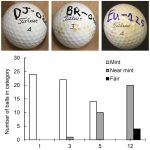Golf clubs are the essential tools that golfers use to navigate the course and complete each hole. The right clubs can significantly impact a golfer’s performance, making it essential to understand the different types of clubs available and their unique characteristics.
Types of Golf Clubs:
Golf clubs are categorized into four main types: woods, irons, wedges, and putters. Each type serves a specific purpose and is designed to help golfers achieve different types of shots on the course.
Woods:
Woods are typically used for long-distance shots from the tee or fairway. They are characterized by their large club heads and low loft angles, which allow golfers to hit the ball farther. The most common types of woods include:
• Driver (1 wood):
The driver is the longest club in the bag and is used primarily for tee shots on par-4s and par-5s. It has the lowest loft angle of any club, typically around 9 to 12 degrees.
• Fairway Woods (3 wood, 5 wood):
Fairway woods have slightly higher loft angles than drivers and are designed for shots off the fairway or from the tee on shorter holes. They offer excellent distance and accuracy and are often used for approach shots into the green.
• Hybrid Clubs:
Hybrid clubs combine the design elements of both woods and irons, featuring a larger club head and a shorter shaft than traditional woods. They are versatile clubs that can be used for a variety of shots and are particularly useful for long approach shots or shots from the rough.
Irons:
Irons are versatile clubs used for a wide range of shots on the golf course. They feature smaller clubheads and higher loft angles than woods, allowing golfers to control the trajectory and distance of their shots more precisely. Irons are numbered from 1 to 9, with lower-numbered irons (e.g., 3 iron, 4 iron) having lower loft angles and longer shafts than higher-numbered irons (e.g., 7 iron, 8 iron). Pitching wedges and gap wedges are also considered irons and are used primarily for short approach shots and shots around the green.
Wedges:
Wedge clubs are designed for shots around the green and in bunkers, where precision and control are essential. They feature higher loft angles than irons, allowing golfers to generate more spin and stop the ball quickly on the green. The most common types of wedges include:
• Pitching Wedge:
The pitching wedge is used for approach shots from the fairway or rough and is designed to provide a high trajectory and soft landing on the green.
• Gap Wedge:
Also known as an approach wedge or utility wedge, the gap wedge fills the gap between the pitching wedge and the sand wedge. It is used for approach shots from distances where the pitching wedge would be too long and the sand wedge too short.
• Sand Wedge:
The sand wedge is designed specifically for shots out of bunkers and soft sand. It features a wide sole and a high loft angle, allowing golfers to get the ball out of the sand and onto the green with ease.
• Lob Wedge:
The lob wedge has the highest loft angle of any wedge and is used for short shots around the green that require a high trajectory and minimal roll. It is ideal for hitting flop shots over hazards or obstacles.
Putters:
Putters are the most specialized clubs in the golf bag and are used exclusively on the putting green. They are designed to roll the ball smoothly along the grass and into the hole with precision and accuracy. Putters come in a variety of shapes and styles, including:
• Blade Putters:
Blade putters have a traditional, narrow clubhead shape and are popular among golfers who prefer a classic look and feel. They offer excellent feedback and control on short putts.
• Mallet Putters:
Mallet putters have a larger, more forgiving clubhead design with additional weight distributed around the perimeter. They are popular among golfers who struggle with consistency on their putting stroke and offer increased stability and forgiveness.
• Counterbalanced Putters:
Counterbalanced putters feature a longer shaft and additional weight in the grip end, which helps stabilize the stroke and promote a smoother putting motion. They are often used by golfers who struggle with consistency in their putting stroke.
Specialty Clubs:
In addition to the standard categories of woods, irons, wedges, and putters, there are also specialty clubs designed for specific situations or player preferences. These clubs may include:
• Driving Irons:
Driving irons are long irons with a lower loft angle than traditional irons, designed for maximum distance off the tee or from the fairway.
• Chipper Clubs:
Chipper clubs are a hybrid between a putter and a wedge, designed for chipping around the green from tight lies or short rough.
• Custom-fit Clubs:
Custom-fit clubs are tailored to an individual golfer’s specifications, including club length, lie angle, loft angle, and shaft flex. Custom fitting can help golfers optimize their performance and improve their consistency on the course.
Choosing the Right Golf Club
Selecting the right golf clubs for your bag is crucial for maximizing your performance on the course. Consider the following factors when choosing golf clubs:
• Skill Level:
Choose clubs that match your skill level and playing style. Beginners may benefit from forgiving clubs with a larger sweet spot, while more experienced golfers may prefer clubs that offer greater workability and control.
• Course Conditions:
Consider the typical conditions of the courses you play and choose clubs that are suited to those conditions. For example, if you frequently play courses with narrow fairways and thick rough, you may want to prioritize accuracy and forgiveness in your club selection.
• Club Fitting:
Optimize your golf clubs with a personalized fitting to align with your body, swing characteristics, and performance objectives. A custom club fitting can help optimize your launch conditions, ball flight, and shot dispersion, leading to improved consistency and performance on the course.
Maintenance and Care of Golf Clubs
Proper maintenance and care of your golf clubs are essential for preserving their performance and longevity. Follow these tips to keep your clubs in top condition:
• Clean Your Clubs Regularly:
After each round of golf, clean your clubs with warm, soapy water and a soft-bristled brush to remove dirt, grass, and debris from the club heads and grooves. Dry them thoroughly with a towel to prevent Rust and corrosion.
• Inspect Your Clubs Periodically:
Check your clubs regularly for signs of wear and tear, including dents, scratches, and loose ferrules. Replace any damaged or worn-out grips, shafts, or club heads to maintain optimal performance.
• Store Your Clubs Properly:
Store your clubs in a cool, dry place away from extreme temperatures and humidity. Use headcovers to protect your woods and putters from damage during transport and storage.
• Schedule Regular Maintenance:
Schedule regular maintenance checks with a professional club fitter or repair technician to ensure your clubs are in good working condition. Have your clubs inspected, cleaned, and adjusted as needed to maintain peak performance on the course.
Frequently Asked Questions (FAQs)
1. What are the main types of golf clubs?
The main types of golf clubs are woods, irons, wedges, and putters. Each type serves a specific purpose and is designed for different types of shots on the golf course.
2. How many clubs are allowed in a golf bag?
During a round of golf, players can carry a maximum of 14 clubs in their bag, as stated by the rules of golf. This includes any combination of woods, irons, wedges, and putters.
3. How do I know which golf clubs to use for different shots?
Choosing the right club for each shot depends on factors such as distance, lie, and obstacles on the course. Woods and hybrids are designed for making longer shots. On the other hand, shorter clubs, such as irons and wedges, are perfect for executing shorter approach shots as well as shots around the green.
4. What is the difference between a blade putter and a mallet putter?
Blade putters have a traditional, narrow clubhead shape and are popular among golfers who prefer a classic look and feel. Mallet putters, on the other hand, have a larger, more forgiving clubhead design with additional weight distributed around the perimeter. Mallet putters offer increased stability and forgiveness on off-center hits.
5. What is custom club fitting, and why is it important?
Custom club fitting involves tailoring the specifications of your golf clubs to match your physique, swing characteristics, and performance goals. A custom club fitting can help optimize your launch conditions, ball flight, and shot dispersion, leading to improved consistency and performance on the course. Ensuring that golfers at every level of skill properly fit their clubs is crucial to unlocking their full potential.
6. Are expensive golf clubs worth the investment?
The value of expensive golf clubs depends on factors such as your skill level, playing frequency, and personal preferences. While high-end clubs may offer advanced features and materials that can enhance performance, they may not necessarily be the best option for every golfer. It’s essential to consider factors such as club fitting, performance testing, and budget when investing in new golf clubs.
7. Can I use golf clubs that are too long or too short for my height?
Using golf clubs that are the correct length for your height is essential for achieving proper posture, balance, and swing mechanics. Clubs that are too long or too short can negatively impact your performance and lead to inconsistency on the course. Consult a professional club fitter to ensure your clubs are the right size and fit for your body and swing.
8. How can I improve my golf game with the right set of clubs?
The right set of golf clubs can help you improve your game by providing consistency, accuracy, and confidence on the course. To improve as a golfer, choose clubs that suit your skill level, playing style, and performance goals. This will help you play better and reach your full potential. Additionally, regular practice, proper technique, and ongoing learning are essential for continued improvement and success in golf.
Conclusion
Understanding the different types of golf clubs and selecting the right clubs for your bag are essential steps in improving your performance and enjoyment of the game. By familiarizing yourself with the characteristics and uses of woods, irons, wedges, and putters, you can make informed decisions about your club selection and optimize your performance on the course. Whether you’re a beginner learning the basics of the game or an experienced player looking to fine-tune your equipment, the right golf clubs can make all the difference in your golfing experience.
This comprehensive guide covers all aspects of different types of golf clubs, from their design and characteristics to their selection, maintenance, and care. Whether you’re a novice golfer just starting or an experienced player looking to improve your game, understanding the nuances of golf clubs is crucial for success on the course.





